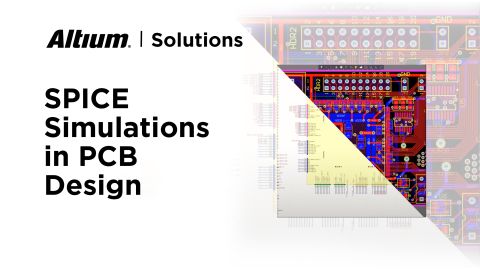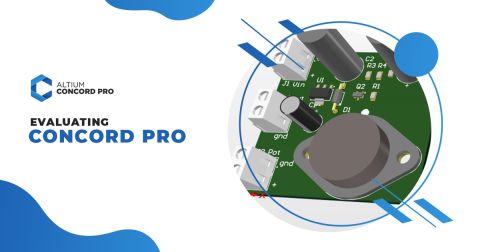Altium Concord Pro: Real-time PCB Component Traceability for All Requirements

Altium Concord Pro™ as a standalone product and brand name has been discontinued and the capabilities are now available as part of our Altium enterprise solutions. Learn more here.
PCB designers and project managers in highly regulated industries face a number of obstacles when managing the design process and preparing for manufacturing. Aside from paying attention to industry standards, and performance requirements, and coordinating electrical and mechanical design teams, component sourcing carries its own requirements. Supply chain glitches can delay a prototyping or high-volume manufacturing run by weeks or even months, and project managers need management tools to expedite production planning and aid compliance.
In highly regulated industries, project managers and designers also need PCB component traceability and supplier quality tools that give them a live view of the supply chain. There are some proprietary tools from component distributors that give you a partial view of the supply chain, but only Altium Concord Pro real-time integrates these important features alongside your PCB traceability requirements. You’ll have full supply chain visibility and component traceability with Altium Concord Pro.
ALTIUM CONCORD PRO®
A unified data management and component traceability platform that integrates with Altium Designer® and other mechanical design tools.
Military, medical devices, and aerospace; are just a few of the highly regulated industries that come with strict industry standards and regulations on component traceability. In the event of a recall, every component needs to be traceable back to its source, as this will determine the extent and costs involved when recalling products. This also helps prevent manufacturing delays and potential rework as electronic components can be accurately tracked back to the distributor and manufacturer.
Given the importance of PCB traceability requirements, project managers and PCB designers need data management tools that provide real-time supply chain visibility and component updates as they become available. Your PCB data traceability and design should help you navigate a complicated supply chain landscape while still providing the sourcing updates you need to keep your circuit designs competitive.
The Importance of PCB Component Traceability Requirements
Larger electronics companies are already familiar with the problems that can arise due to a lack of supply chain visibility, real-time component updates, and poor requirements management tools. These larger companies tend to be heavily regulated and highly specialized in their respective industries. These behemoths also have complex logistics systems for tracing everything from electronic components to raw materials back to their sources.
Although these larger companies tend to deal with huge manufacturing runs and that can be a logistical nightmare, these same problems involved in sourcing and traceability also affect smaller companies in the same way. Smaller companies that do not have live access to component updates, an effective requirements management process, or accurate supply chain information can see the same increased turnaround times and sourcing delays that affect larger electronics companies.
Individual designers like to create their own personal libraries, and smaller organizations tend to compile component and sourcing information into company databases so that it can be accessed within their PCB layout software. Larger companies tend to implement similar systems, although they have enough resources to manually update their systems in order to comply with material traceability and sourcing requirements.
A New Dynamic: Component Data Management in Your Design Software
Private component databases are inevitably due to the speed at which the electronic component supply chain changes. As new components become available, models and footprints for these components need to be immediately accessible to engineers and designers. This aids requirements management and ensures a new product will have the longest lifetime and remain competitive. This is where a managed supply chain visibility solution becomes invaluable for satisfying performance and sourcing requirements.
Printed circuit board designers that have instant access to supply chain information within their design software don’t have to question the reliability of their internal databases during the design phase. This also ensures engineers that design schematics are including the most recent versions of components that are actually Sourceable. When building a PCB layout, a designer can easily identify obsolete or unsourceable components and quickly find suitable replacements.
- The supply chain can change between the time you create your bill of materials and the moment it is received by your manufacturer. You can anticipate supply chain changes with data management tools that allow you to instantly select replacement components.
- Supply chain visibility tools help you keep costs in check by reducing turnaround times, preventing redesigns, and allowing cost comparisons. This also ensures your new product can satisfy performance requirements.
See how you can control costs with real-time supply chain visibility tools.
- The sourcing landscape already changes quickly, but libraries that include instant updates help you keep up with supply chain changes and avoid delays in the manufacturing process.
See why you need component libraries that provide real-time updates.
Real-time supply chain control with IHS integration in Altium Designer
Taking Advantage of PCB Component Traceability Tools
By now one should realize that supply chain information is important when it comes time to manufacture your board, but so are component and raw materials traceability. Supply chain visibility and material traceability really go hand-in-hand to ensure that your device can meet performance requirements while remaining compliant with industry standards and government regulations.
These traceability features work best when they appear alongside your PCB layout tools and can be accessed within the same program. Most design platforms that offer similar features only check against a private database or a select number of distributors. These databases inevitably go stale and require some maintenance to ensure that data is kept up to date. Instead of manually checking and updating component databases, printed circuit designers need a managed solution that provides traceability information alongside updated component models and footprints.
Going Further: Traceability Within ECAD/MCAD Co-design
ECAD and MCAD co-design is one great way to ensure your new product can meet your enclosure and packaging requirements, as well as tailor your circuit board so that it meets mechanical requirements. Integration between these design tools improves productivity and allows collaboration between formerly siloed design teams. This is a natural extension for PCB data traceability and manufacturing.
Adding traceability to your MCAD design tools allows you to immediately check the traceability and source ability of components in your mechanical model. It also allows you to check whether replacement components will fit into your mechanical enclosure, further ensuring that you satisfy the mechanical requirements for your new product.
- Even small companies and service bureaus can benefit from a managed component data solution.
Learn more about the benefits of data management with Ben Jordan.
- Integrated design, documentation, and production planning tools allow you to quickly import your component information and souring data into your bill of materials.
- With electronic component shortages quickly becoming the norm, data management solutions that provide sourcing and traceability data can help you anticipate and adapt to supply chain changes.
Learn more about managing component shortages with John Watson.

Enhanced MCAD design tools in Altium Concord Pro
Best Tools and Resources for Component Traceability
These pain points around component sourcing might sound like major challenges that require multiple tools and managed datasets from multiple vendors. In the past, designers and project managers were forced to crawl distributor websites or use separately managed databases that do not provide full supply chain visibility. This slows down the production planning process and doesn’t help you meet your component traceability requirements.
If you have tools that provide supply chain visibility directly in your PCB layout software, you won’t be blindsided by changes in the supply chain once your designs reach your manufacturer. Enter Altium Concord Pro: the only managed component database that integrates directly alongside the industry-standard design tools in Altium Designer. Component data updates will quickly pass to your schematic and layout, and you can quickly access sourcing information at the click of your mouse.
Enhance Altium Designer with Altium Concord Pro
With Altium Concord Pro, project managers, and PCB layout designers have the tools they need to ensure the components that appear in their designs are fully traceable and up to date. The infamous “footprint not found” error that plagues other design programs is solved thanks to the unified data model that drives Altium Designer and Altium Concord Pro. These features are easily accessible within Altium Designer and are integrated alongside your standard PCB layout and manufacturing planning features.
The level of integration offered by Altium Concord Pro does not stop there. These component models and footprint updates are passed directly into the native MCAD tools in Altium Designer, and they integrate with other programs like SolidWorks and Autodesk Inventor as plugins. This makes enclosure design more accurate and allows mechanical designers to collaborate alongside electrical designers. You’ll never need another piece of 3rd party component traceability software.
- Altium Designer’s unified environment for circuit board design only improves with the data management and sourcing tools in Altium Concord Pro. Importing real-time data into your PCB layout software helps reduce lead times and prevents unnecessary rework during the manufacturing process.
- The native 3D printed circuit design tools in Altium Designer integrate directly with the data management tools in Altium Concord Pro. All aspects of circuit board design and management can finally proceed in a single package, and you’ll be able to easily create your bills of materials in this ecosystem.
Learn more about the bill of materials and requirements management in Altium Designer.
- No one wants to manually rearrange their circuit board after receiving component updates. Altium Concord Pro allows you to easily replace obsolete or unavailable components instantly.

Complete component data management is possible on-premises with Altium Concord Pro
Altium Designer’s integrated printed circuit design interface is unmatched by other PCB design platforms. Other ECAD and MCAD tools offer little in the way of data management, and they offer nothing to aid component and material traceability. When you complement Altium Designer with Altium Concord Pro, your productivity will only increase and you’ll be able to easily remain compliant with industry and regulatory standards.
Altium Designer is the only unified software package that integrates printed circuit board layout and production process into a single package, and you can complement your data management process with Altium Concord Pro. This managed data solution also integrates your data management and printed circuit design features with popular MCAD tools, allowing you to manage all aspects of your design in one unified platform. Anyone that uses Altium Designer can watch their productivity skyrocket with Altium Concord Pro.










